Looking for LiquidPlanner alternatives? This post will show you 10 best liquidplanner alternatives that you never knew before. A fantastic SaaS project management tool is LiquidPlanner. It enables you to control project uncertainty and adjust to changes. to monitor the team’s availability and establish priorities. to create a large-scale project management pipeline. However, LiquidPlanner might not work for your company.
For starters, the app’s cost (beginning at $45 per user/per month) can put off entrepreneurs on a tight budget. To start, you might desire a free app. You might choose something straightforward or sophisticated. Consider reading this comparison of project management software.
In light of this, you might want to check at programs like LiquidPlanner. What LiquidPlanner alternatives are the best?
Summary of Contents
Top 10 companies that have products similar to LiquidPlanner
These are the LiquidPlanner alternatives that, in our opinion, are the best available. Despite the fact that they are all somewhat similar, some of them will be more appropriate for your situation than others. Therefore, read more in the sections below about each choice.
The complete list of top LiquidPlanner alternatives for 2022 is provided below:
10 Best LiquidPlanner Substitutes for Project Management
Based on features and overall value, we’ve offered a “top” choice. The most comparable substitute, the least expensive substitute, the finest free substitute, and more. You can then weigh factors like your budget, your toolkit, and your desired app integrations.
1.Wrike
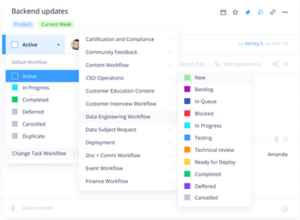
Benefits:
An all-inclusive project management tool is Wrike. Co-located and remotely distributed teams are its intended audience. The platform is made to give projects and tasks complete visibility and openness. to handle incoming task requests, hasten approvals, and enhance team collaboration You can keep track of workflows, see who did what, and keep an eye on everything.
Print up reports for each team member and total up the project hours. Compliance and auditing are made simple with the aid of task and time management systems. For agile project management, create personalized scrum workflows.
Strong data reporting tools are also available. Business intelligence tools can also be added for deeper reporting and analytics. It works well with Microsoft Teams and Outlook. Therefore, managing Microsoft projects on the app is simple.Check this article on Intacct Alternatives.
Drawbacks:
The user interface might be more simple to use. Additionally, the program requires a lot of setup before it can be used regularly.
Pricing:
There is a free plan that supports up to 5 people. The annual cost of the professional plan for 5, 10, and 15 users is $9.80 per user/per month. Business plans for 5 to 200 users cost $24.80 each month per user, payable yearly.
The Wrike sales staff must be contacted in order to purchase the Enterprise subscription for 5-Unlimited users. Each of the Professional, Business, and Enterprise plans offers a 14-day free trial.
2.Trello

Benefits:
The best free LiquidPlanner substitute is Trello. Why? since the project management app’s free edition has all the features. The 10MB file attachment size restriction is the only restriction.
Trello provides straightforward, graphical web-based project management tools. It is adaptable and simple to use. built around Kanban boards to control workflows for productivity. Cards have information that is immediately visible. Each card has space for comments, files, and due dates. Make useful lists as well.
Additionally, the tool goes beyond task management and boards for project planning. The “Butler” tool also provides workflow automation. Establish guidelines, start events, and schedule orders. Slack, Evernote, Dropbox, and Google Drive are all integrated with Trello. additional numerous third-party programs, too. You can sync it with all the tools you already use thanks to this.
The app has long been a go-to for independent contractors, new businesses, and small teams. Even as a tool to plan your forthcoming family holiday, it is promoted. We’re talking about simplicity at that level. Check this article on pipedrive alternatives.
Drawbacks:
Simply put, Trello is not a powerful project management tool. Your project might not be able to keep up if it includes a lot of moving pieces, like, say, the creation of software. especially if you’re seeking for in-depth stats and analytics.
Pricing:
There is a free plan that allows for unlimited cards and a 10MB attachment restriction.
The Business Class package costs $12.50 per user per month when paid monthly and $9.99 per user per month when paid annually. The annual cost of the Enterprise Class plan for 20 or more users is $17.50 per user/per month. As the user base grows, the price per user decreases. The Business Class plan is accessible for a 14-day free trial.
3.Monday.com
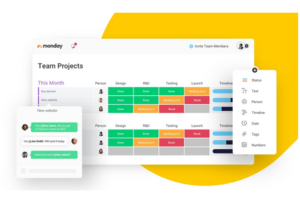
Benefits:
The rival app that is most similar overall is monday.com.
Similar types of customers are served by LiquidPlanner and Wrike. Alternatively put, small to medium firms (somewhere between 1 to 1,000 people). Agile project management or resource management, and document management are all capabilities of both software systems. Gantt charts, Kanban boards, budget tools, and milestone tracking for projects.
Additionally, they both have desktop web-based apps, Windows, and Mac versions. and mobile applications for iOS and Android. Monday.com is infamous for its clean, approachable interface. one that prioritizes the use of collaboration tools. You may organize workflows and streamline tasks with the app. synchronize data between several business programs. A project portfolio management system is also available for monitoring all projects.
Monday.com encourages productivity and alerts everyone to what needs to be done. The software enables team members to navigate and view the entire larger picture by clicking around. That’s fantastic for project alignment and morale, too. Check this article on vcita alternatives.
Drawbacks:
Some users have called the mobile app “clunky” since it lacks some capabilities seen in the desktop app. lacks the ability to record calls.
Pricing:
The basic plan costs $25 per user, each month, when paid for yearly. The regular plan costs $39 per user/per month when paid annually. The Pro plan costs $59 per user, each month, when paid for yearly. Enterprise plan customers must get in touch with Monday.com.
There is a 14-day free trial offered without a credit card. Unlimited users and boards are included.
4.Airtable
![]()
Benefits:
Spreadsheets are transformed into functional work tools via Airtable. Additionally, it offers a versatile work environment that may accommodate a wide range of corporate roles.
Howie Liu, the CEO of Airtable, worked as a product manager for Salesforce. However, the digital tool his new employer created is a lot simpler than the CRM at his previous company. For start-ups and small organizations, it may be a CRM, a project management tool, or a collaboration platform. Users of Airtable can simply link data from several sets and analyse it. It’s simple to import and export data from.CSV files.
You can create custom fields using the drag-and-drop dashboard. can fill them with anything you want, such as connections to records in other tables, run-on long-form text notes, checkboxes, and attachments. barcodes included.
And you’re covered if you have any platform-related questions. User feedback for Airtable’s customer service is positive. Check this article on Sales Tools to Boost Business Growth.
Drawbacks:
The platform probably won’t be able to handle task management and more complex job operations.
Pricing:
The free version offers necessary functionalities.
The annual fee for the Plus version is $10 per user/per month. Pro version annual billing is $20 per user/per month. Contact with Airtable is required for the Enterprise version.
5.Asana
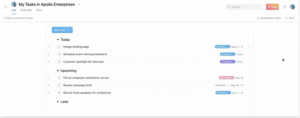
Benefits:
The entry-level premium subscription for Asana is $10.99 per user/per month. When compared to LiquidPlanner’s beginning price of $45 per user/per month, this is a sizable reduction. Asana is a team-oriented online project management tool. It facilitates project collaboration. to interact and keep track of work using the platform’s numerous dashboards.
All of one’s chores can be seen in list form or plotted on a calendar. There is a board view that moves tasks through stages in accordance with the Kanban method. Team members actually don’t need to rely on emails, other chat apps, or cloud services to contribute comments and media because Asana has capabilities for dialogue and file sharing.
The timeline function resembles a cross between a vision board and a calendar. Projects are laid out in accordance with a perfect plan. Everyone involved and motivated to accomplish deadlines as a result. It works well for large-scale initiatives like whole website redesigns, the introduction of new products, marketing campaigns, and even event planning.
The app is available for free. It focuses on managing projects for small teams and individual labor. And it works fairly well. Check this article on Logmein Alternatives.
Drawbacks:
Setting up your workflow can be challenging due to the abundance of features. The task layout view’s lack of great intuitiveness does not help.
Asana’s assigned tasks board and inbox can easily become cluttered with random items. To keep them from becoming cluttered, you need to be a good housekeeper.
Pricing:
Free basic plan for both individuals and teams.
The premium plan costs $13.49 per user, per month when paid monthly, and $10.99 per user, per month when paid annually. Business plan costs $30.49 per user, per month when paid monthly, and $24.9 per user, per month when paid annually. Enterprise plan calls for interaction with Asana. The Premium and Business programs also provide a risk-free trial.
6.Smartsheet
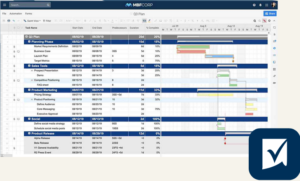
Benefits:
Aligning people and technology is the concept underlying Smartsheet. Finding information or attending meetings takes up about a third of the workday. Therefore, the tool’s fundamental goal is to reduce this wasted time and increase the agility of your company.
Software for managing projects and tasks called Smartsheet makes it simple to share work using Gantt charts and other views. Additionally, it features a ton of automation, time tracking, and reporting options.
Tools are available that are designed expressly for growing your business while reducing risk. You may create intricate workflows with personalized automation rules using the Control Center dashboard.
The Live Data Connector tool enables the transfer of Smartsheet data to Microsoft Excel. This enables you to combine various data sheets into a single Excel file. to format data, arrange it, and gain instantaneous insights. Check this article on SAP Alternatives.
Drawbacks:
lacks a ticketing or chat mechanism. Although the interface is practical, it lacks warmth and personality.
Pricing:
The monthly cost for an individual plan is $14 per user, payable yearly.
The annual fee for the business plan is $25 per user, each month.
Enterprise plan needs to get in touch with Smartsheet. Contact with Smartsheet is necessary for the Premier plan (Enterprise features with premium options). There is a free trial period of 30 days. No credit card is necessary.
7.Basecamp
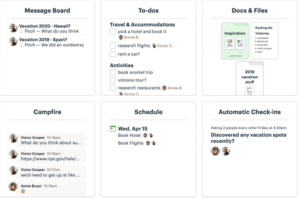
Benefits:
Basecamp is made to boost efficiency and organization. This is accomplished by integrating job management dashboards, file storage, and communication systems. Create projects from the work. Include in each project anybody who needs to be involved.
Each project has its own to-do lists, message board, and group chat. Additionally, a common schedule. You may also program automatic check-ins to ask team members to provide a status update.
Effective as a broad cloud storage platform. Upload and distribute files, spreadsheets, pictures, and documents. Organize your files to keep track of anything project-related. The app is available for free. Because of this, freelancers and small NGOs can use it. also for independent endeavors. Check this article on Sales Tool to Increase Revenue.
Drawbacks:
lacks a concise, cohesive overview that would allow team members to see one another’s work. It’s not a really robust piece of task management software, in general.
Nice and easy pricing structure. The aim of the paid verison, though, is probably out of several small teams’ and startups’ price range.
Pricing:
Basecamp Personal is without cost. Basecamp Business costs $99 per month for unlimited projects and users. No per-user charges are levied. The Basecamp Business plan is available for a free trial period of 30 days. No credit card is necessary.
8.Zoho Projects (if you want to connect to CRM)
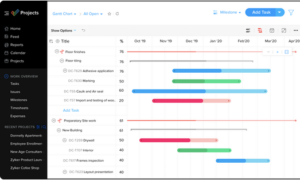
Benefits:
a cloud-based application for project team management. aids in task planning, task tracking, and remote team collaboration. effortlessly integrates with Zoho CRM and the other Zoho suite products. Gantt charts aid in the creation of project plans. Keep tabs on important chores. Check to see if anticipated progress differs from actual progress at a glance. To save time, automate repetitive processes. Create automation rules by using a drag-and-drop interface to visualize them.
You can record both billable and non-billable hours on timesheets. This is quite advantageous for billing. Additionally, there is a direct link with Zoho Invoice, which will create invoices automatically from timesheets. Check this article on salesforce alternatives.
Additionally, you can link Zoho Projects to a huge variety of other programs using Zapier. Slack and Excel are two examples.
Drawbacks:
The user interface is not the most aesthetically beautiful or intuitive. Only tasks contained within individual projects are searchable.
Pricing:
There is a free plan that allows for 3 users and 2 projects.
The standard plan is $3 per user/per month invoiced monthly and $2.50 per user/per month billed annually for 6–10 users. The Express plan costs $3 per user/per month when billed annually and $4 per user/per month when billed monthly for 12 to 50 users. The premium plan is $4 per user/per month invoiced annually and $5 per user/per month billed monthly for users between 15 and 100.
Enterprise plans cost $5 per user, per month, billed annually, and $6 per user, per month, billed monthly, for the first 20 users. All paid programs come with a free trial period of ten days.
9.Clarizen (best alternative if you want integration with Microsoft Teams)
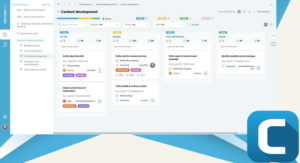
Benefits:
Clarizen is a comprehensive PM tool for coordinating teams, maintaining agility, and completing tasks. You can also identify who is responsible for what and change tasks, priorities, and project timeframes using a single view. Milestones, task reporting, and Gantt charts are examples of project management characteristics. Do project-based billing as well. Check this article on Xero Alternatives.
Project templates are simple to make and can be rapidly customized. Create custom processes with a variety of boards for various clients, teams, or projects. Easily add team members, external stakeholders, and comments to tasks. For Microsoft projects, the app includes direct connection with Zoom and Teams. It can be linked to countless different systems using Zapier.
Drawbacks:
Pricing begins at $29.95 per user/per month, which may be out of some people’s price ranges. The outmoded user interface could be a major barrier to widespread team adoption.
Pricing:
The monthly cost of Clarizen Go for Agile Teams is $29.95 per user, payable yearly. Enterprise Edition calls for speaking with Clarizen. Contact with Clarizen is required for the Unlimited Edition. Clarizen Go offers a free trial that lasts for 30 days.
10.Jira
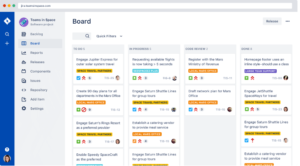
Benefits:
geared for teams working on Agile and Lean software development. includes tools for continuous integration and deployment as well as knowledge management and development workflow.
The platform is built around visual dashboards that you can drag and drop. Big picture roadmaps, Kanban boards, and Scrum boards. Check this article on Freshbooks alternatives.
You may keep building depth and intricacy into projects like a matryoshka doll. Assign tasks, and make each assignment dependent on the previous one. Within larger tasks, create smaller ones. Jira is incredibly adaptable, and there are numerous methods to increase its feature set. There is a Jira app for GitHub. In order to link your coding efforts with Jira projects.
Additionally, Jira Service Desk is easily integrated with the app. This enhances help desk capabilities. Jira offers very high levels of data security and encryption. It complies in large part with the US/EU Privacy Shield and ISO/IEC 27001 security standards. a lot of other programs, too.
Drawbacks:
The user interface is unusual. Finding workflows and understanding them might be difficult. This makes the platform’s learning curve moderate.
Pricing:
There is a free plan that supports up to 10 people. The standard plan is $7 per user, per month, payable yearly, for up to 5,000 members. The monthly premium package for up to 5,000 users costs $14 when paid annually. The Standard and the Premium plans are available for a 7-day free trial.
What free LiquidPlanner alternatives are the best?
These are the top ten free LiquidPlanner substitutes:
1.Airtable
2.Asana
3.Basecamp
4.Jira
5.Podio
6.Teamwork
7.Trello
8.Wrike
9.Zenkit
- Zoho Projects
Which of the LiquidPlanner alternatives is the best option for you?
Everyone wants project management to be simple. a comprehensive tool for assessing your progress at work. to manage tasks and processes while planning resources.
What is the finest LiquidPlanner substitute?
We speculated that it might be Wrike in this article. according to features.
Having said that, it actually depends. Are you seeking a program that is comparable to LiquidPlanner? something less costly?
We therefore provided 9 additional options depending on the top priorities. Moreover, there is a list of cost-free options. Furthermore, LiquidPlanner is not necessarily superior to any of the provided apps. However, they might suit your needs better. When a good, practical PM tool is used, both project managers and team members gain. Check out the tools mentioned above, then filter the list based on your top choices for features. After that, use free trials to contrast shop.

